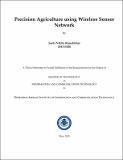| dc.contributor.advisor | Shrivastava, Sanjay | |
| dc.contributor.author | Joshi, Nikita Rajeshbhai | |
| dc.date.accessioned | 2017-06-10T14:43:01Z | |
| dc.date.available | 2017-06-10T14:43:01Z | |
| dc.date.issued | 2015 | |
| dc.identifier.citation | Joshi, Nikita Rajeshbhai (2015). Precision agriculture using wireless sensor network. Dhirubhai Ambani Institute of Information and Communication Technology, x, 50 p. (Acc.No: T00515) | |
| dc.identifier.uri | http://drsr.daiict.ac.in/handle/123456789/552 | |
| dc.description.abstract | Farming practices should evolve with the rapid increase in population. Recent
growth in wireless sensor network (WSN) has the capability to meet this objective.
Better quality in crop production can be achieved using real-time data collected
through WSN. Also, greenhouse allows farming in a controlled environment.
Hence, a combination of WSN and greenhouse gives better quality crop
yield.
Greenhouse requires climate control and fertigation management. Fertigation
is a combination of irrigation and fertilization. Existing architectures for greenhouse
management collect data of various parameters using sensor nodes and
control values of parameters using actuators. These architectures have very limited
capability to handle faults in sensors and actuators. Deployment of sensor
nodes in these architectures is crop dependent. Therefore, while changing crops,
modifications in the location of sensor node is needed and details of this modification
should be entered manually in the database. Thus, they are not flexible
architectures.
In our work, a WSN based architecture for controlled environment like greenhouse
is designed. This architecture provides for actuator control using crop
requirements stored in the database. The architecture provides for deployment
strategies for sensor nodes and actuators using the details about bed size, crop
requirements etc. Localization algorithm is used to find the exact location of the
sensor node. The architecture is flexible such that whenever location of sensors
nodes needs to be changed, location of sensor nodes will be automatically detected
using the localization algorithm. We have designed an algorithm to detect
faults in sensor nodes and actuators. These faults are isolated or reported to the
user. The architecture provides for network management strategies to control energy
consumption of sensor nodes which eventually helps in increasing network
lifetime. WSN algorithms for sleep scheduling and localization are used to support
these features.We designed a system for a specific group of crops namely tomato, capsicum
and cucumber using the architecture. This system is simulated in NS2 and it is
verified that system is working as expected. | |
| dc.publisher | Dhirubhai Ambani Institute of Information and Communication Technology | |
| dc.subject | Wireless communication systems | |
| dc.subject | Electric conductivity | |
| dc.subject | Measurement | |
| dc.subject | Wireless sensor networks | |
| dc.subject | Agriculture | |
| dc.subject | Data processing | |
| dc.subject | Computer network protocols | |
| dc.subject | Research | |
| dc.subject | Communications protocols | |
| dc.classification.ddc | 621 JOS | |
| dc.title | Precision agriculture using wireless sensor network | |
| dc.type | Dissertation | |
| dc.degree | M. Tech | |
| dc.student.id | 201311020 | |
| dc.accession.number | T00515 | |

